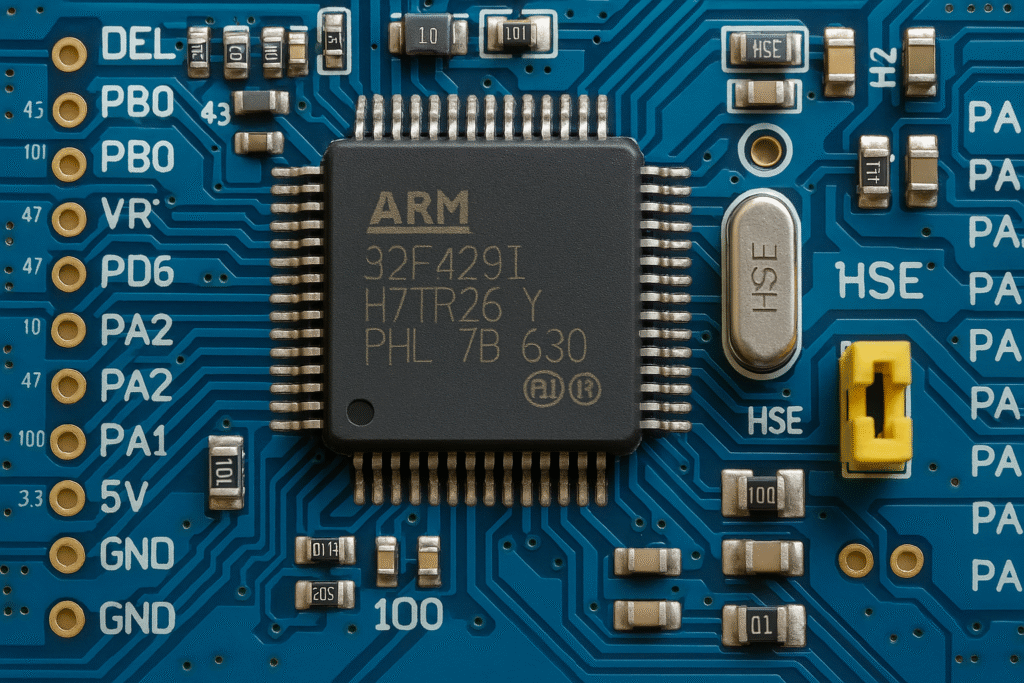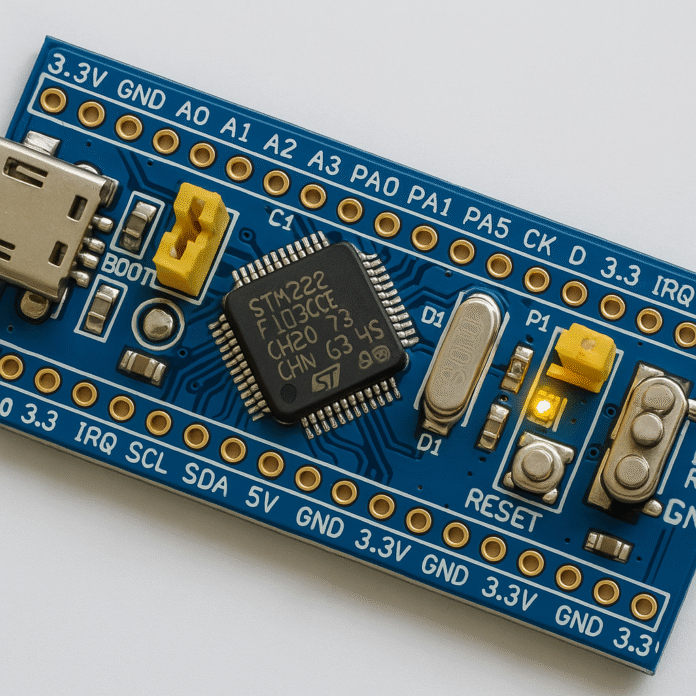When it comes to embedded systems, STM 32 microcontrollers are among the most widely used solutions in industries ranging from automotive to consumer electronics. Their versatility, performance, and affordability make them an ideal choice for engineers and developers. One of the important aspects of working with STM32 devices is how they integrate into pcb design, since efficient board layouts and hardware integration are vital to achieving performance, reliability, and manufacturability in real-world products.
What is a STM32 microcontroller?
STM32 is a family of 32-bit microcontrollers developed by STMicroelectronics. These devices are based on ARM Cortex-M cores, ranging from Cortex-M0 for entry-level applications to Cortex-M7 and Cortex-M33 for high-performance use cases. They cover a wide spectrum of requirements, including low-power IoT devices, industrial control systems, medical electronics, and robotics.
The STM32 family is divided into several series, such as:
- STM32F0/F1: Entry-level microcontrollers with cost-effective performance.
- STM32F4: High-performance MCUs with advanced peripherals.
- STM32L: Ultra-low-power devices designed for battery-operated systems.
- STM32H7: Top-tier series with very high clock speeds and DSP capability.
Each series provides a balance between power consumption, performance, and peripheral integration, making them highly adaptable.
Is STM32 better than Arduino?
This question comes up frequently among hobbyists and engineers. Arduino boards are beginner-friendly and perfect for prototyping, but STM32 devices offer significantly more processing power, peripherals, and scalability.
- Arduino Pros: Easy to use, massive community, simplified IDE.
- STM32 Pros: Professional-grade performance, broader range of peripherals, industrial adoption, scalability from simple to advanced systems.
If a project requires high processing speed, precise control, or industrial integration, STM32 is the better option. However, for learning and rapid prototyping, Arduino still holds its place.
Is STM32 better than Raspberry Pi?
Comparing STM32 to Raspberry Pi is more nuanced since they serve different purposes.
- STM32: Real-time control, low power, reliable in embedded environments.
- Raspberry Pi: Full operating system (Linux), multimedia capabilities, networking.
For robotics, motor control, or real-time signal processing, STM32 is superior. For applications needing a graphical interface, video playback, or heavy networking, Raspberry Pi is a better fit. In fact, both are often combined—STM32 for hardware control and Raspberry Pi for higher-level processing.

Why is STM32 so popular?
Several reasons contribute to STM32’s popularity:
- Wide selection – Multiple series addressing different needs.
- Strong ecosystem – STM32CubeIDE, STM32CubeMX, HAL libraries.
- Industrial-grade reliability – Qualified for automotive, medical, and industrial use.
- Community and support – Large user base and extensive documentation.
- Affordability – Cost-effective even for high-performance options.
This combination of performance and accessibility makes STM32 a go-to choice across industries.
What coding language does STM32 use?
STM32 microcontrollers are typically programmed in C and C++. The most common development environments are:
- STM32CubeIDE – The official free IDE from STMicroelectronics.
- Keil uVision – Popular for ARM-based microcontrollers.
- IAR Embedded Workbench – Professional-grade development tool.
- PlatformIO – Open-source option with STM32 support.
Additionally, STM32 can be programmed using MicroPython for faster prototyping, though C remains the standard for performance-critical applications.
What are the disadvantages of STM32?
While STM32 is powerful, there are some drawbacks:
- Learning curve – More difficult for beginners compared to Arduino.
- Toolchain complexity – Professional IDEs and debugging tools can be overwhelming.
- Availability issues – Some models face supply chain delays.
- Peripheral configuration – Requires careful setup using STM32CubeMX or direct register programming.
For professionals, these disadvantages are manageable, but for absolute beginners, it might feel intimidating.
Why is STM32 so complicated?
STM32 can feel complicated because of its flexibility. Each microcontroller has multiple configuration options, peripherals, and clock trees. Beginners often struggle with:
- Configuring timers and interrupts.
- Understanding clock domains.
- Setting up peripherals like ADC, SPI, I2C.
However, STM32CubeMX simplifies much of this by allowing graphical configuration of peripherals and generating initialization code automatically.
What is the competitor of STM32?
STM32 competes with several other microcontroller families:
- Microchip PIC32
- NXP LPC series
- Texas Instruments MSP430 and Tiva C series
- Renesas RX and RA series
- Nordic Semiconductor nRF series (for wireless applications)
Among these, STM32 stands out because of its balance between cost, features, and support.
Can STM32 run Linux?
STM32 microcontrollers themselves cannot run full Linux because they lack the memory and hardware requirements for an operating system kernel. However, ST’s STM32MP1 series is a microprocessor that can run Linux. This is a hybrid device combining Cortex-A cores (for Linux) and Cortex-M cores (for real-time control).
STM32 programming
Programming STM32 typically involves:
- Toolchain setup – Install STM32CubeIDE or other toolchains.
- Board connection – Use ST-Link or JTAG/SWD debuggers.
- Code generation – Configure peripherals with CubeMX.
- Firmware development – Write code in C/C++.
- Debugging and flashing – Load code into the device and test.
For beginners, many STM32 boards (like the Blue Pill) have open-source support and can even be programmed via Arduino IDE, lowering the entry barrier.
STM32 software
The STM32 ecosystem includes a wide range of software tools:
- STM32CubeIDE – Integrated development environment.
- STM32CubeMX – Peripheral configuration and code generation.
- HAL & LL libraries – Abstraction layers for peripheral access.
- STM32CubeProgrammer – Flashing and debugging tool.
- RTOS options – FreeRTOS and Zephyr OS for multitasking.
This makes development faster and more structured compared to bare-metal programming.
STM32 Blue Pill
The STM32 Blue Pill is one of the most famous STM32 development boards. Based on the STM32F103C8T6, it became popular because of its:
- Low cost (often under $5).
- Compact design.
- Easy availability.
- Open-source support with Arduino IDE and PlatformIO.
Despite being inexpensive, it has powerful features: 72 MHz ARM Cortex-M3, multiple communication interfaces, and adequate flash and RAM for many applications. It introduced countless engineers and hobbyists to STM32 development.
STM32 in pcb design and real-world applications
When integrating STM32 into pcb design, careful consideration must be given to:
- Power supply decoupling for stable operation.
- Clock crystal placement to minimize jitter.
- High-speed signal routing for SPI, USB, or Ethernet.
- Ground plane optimization for noise reduction.
- Programming and debugging headers for development.
STM32 devices are widely used in:
- Automotive ECUs.
- Medical devices.
- Industrial control systems.
- Consumer electronics like smartwatches.
- Robotics and drones.
This adaptability demonstrates why STM32 has become a trusted choice in both academic and professional projects.
Conclusion
STM 32 microcontrollers are a cornerstone of modern embedded electronics, offering scalability, affordability, and industrial-grade reliability. From entry-level hobbyist projects to advanced industrial automation, STM32 provides a solution that balances performance, power consumption, and cost. While they require a steeper learning curve compared to Arduino, their versatility makes the effort worthwhile. For engineers working on advanced pcb design or product development, STM32 remains one of the strongest options available.
